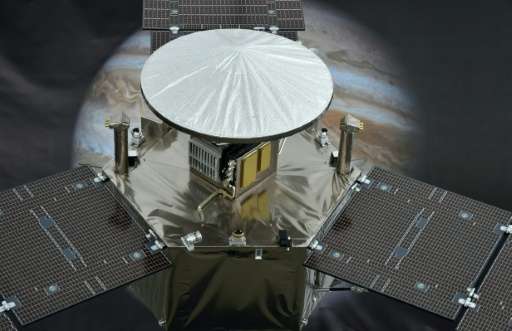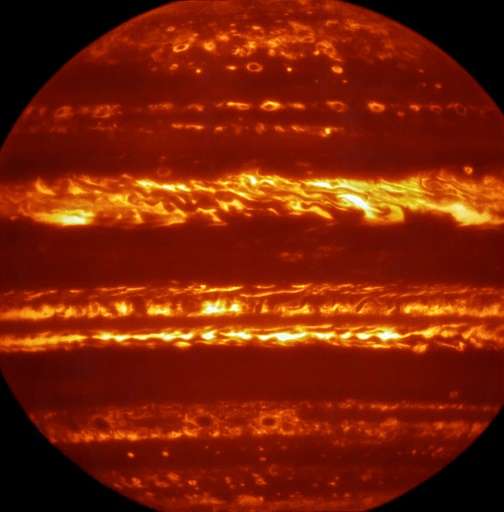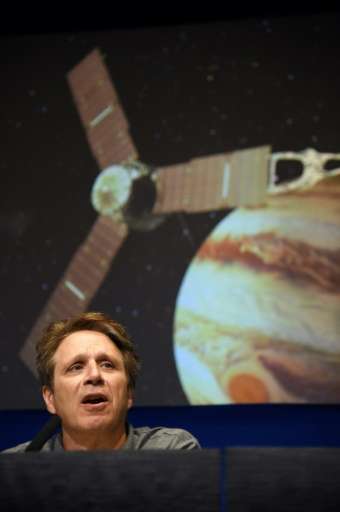NASA counts down to nail-biter orbit of Jupiter (Update)

A $1.1 billion NASA spacecraft called Juno must dodge debris and extreme radiation Monday as it attempts to orbit Jupiter, on a high-stakes mission to probe the origin of the solar system.
Juno is expected to arrive late Monday in the vicinity of the largest planet in our cosmic neighborhood, five years after the unmanned solar-powered observatory launched from Cape Canaveral, Florida.
"We are barrelling down on Jupiter really quick," said Scott Bolton, Juno principal investigator from the Southwest Research Institute in San Antonio, Texas.
As NASA counted down to Juno's arrival, Bolton admitted to being "nervous" and "scared" about the fate of the spacecraft, which is traveling at a speed of more than 130,000 miles per hour (209,200 kilometers per hour) toward what he called "the king of the solar system."
A key concern is that the spacecraft must survive radiation levels as high as one hundred million X-rays in the course of one year, explained Heidi Becker, senior engineer on radiation effects at NASA's Jet Propulsion Laboratory.
These high energy electrons, moving at the speed of light, "will go right through a spacecraft and strip the atoms apart inside your electronics and fry your brain if you don't do anything about it," she said.
"So we did a lot about it," she said, describing the half-inch thick layer of titanium that protects the electronics in a vault and brings the radiation dose down.
Still, she described the close approach as going "into the scariest part of the scariest place... part of Jupiter's radiation environment where nobody has ever been."
Dodge debris
Juno must also avoid debris as it speeds through a belt of dust and meteorites surrounding Jupiter.
"If it gets hit—even by a big piece of dust, even by a small piece of dust—it can do very serious damage," said Bolton.

On approach, the engine doors are open, leaving the nozzle "vulnerable" to debris, he said.
"If any dust is in our way and hits that nozzle, it will knock a hole right through the coating that protects that nozzle and allows the engine to burn uninterrupted," he told reporters.
"That is one of the big gambles."
After that, a tricky, fully automated orbit maneuver must succeed—as the engines fires to slow it down enough to be captured by Jupiter's orbit.
Then, the spacecraft must re-orient itself toward the Sun in order to power the solar arrays.
If it fails to enter orbit, Juno may shoot past Jupiter, bringing a mission 15 years in the making to a swift end some 540 million miles (869 million kilometers) from Earth.
NASA television coverage of the event begins at 10:30 pm US Eastern time (0230 GMT Tuesday).
The orbit insertion should be complete at around 12 am Eastern time July 5 (0400 GMT), NASA said.
How Jupiter formed
Scientists hope to find out more about how much water Jupiter holds and the makeup of its core, in order to figure out how the planet—and others in the neighborhood including Earth—formed billions of years ago.
Jupiter is the fifth planet from the sun and is the most massive planet in the solar system.

Its atmosphere is made up of hydrogen and helium, and it's known for its Great Red Spot, a storm bigger than Earth that has been raging for hundreds of years.
Since Juno is the first mission designed to see beneath Jupiter's clouds, it is named after the Roman goddess who was the wife of Jupiter, the god of the sky in ancient mythology.
She was said to be able to see through the clouds Jupiter veiled himself with to hide his mischief.
The NASA mission aims to orbit Jupiter from pole to pole, sampling the charged particles and magnetic fields for the first time and revealing more about the auroras in ultraviolet light that can be seen around the planet's polar regions.
Juno should circle the planet 37 times before finally making a death plunge in 2018, to prevent the spacecraft from causing any damage to any of Jupiter's icy moons, which NASA hopes to explore one day for signs of life.
Juno is not the first spacecraft to orbit Jupiter but NASA says its orbit will bring it closer than its predecessor, Galileo, which launched in 1989.
That spacecraft found evidence of subsurface saltwater on Jupiter's moons Europa, Ganymede and Callisto before making a death plunge into Jupiter in 2003.
NASA says Juno should be able to get closer than Galileo—this time within 3,100 miles (5,000 kilometers) above the cloud tops.
"We have done everything humanly possible to make this mission a success," said NASA's director of planetary science, Jim Green.
"It is still a cliffhanger for me, too."
© 2016 AFP





















